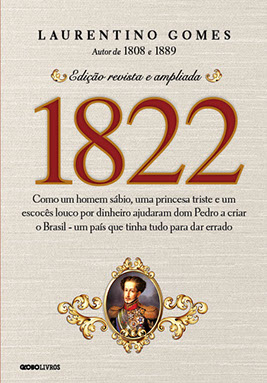
1822, a detailed study of the trajectory of Brazil’s Independence, is the title of the second book by journalist and writer Laurentino Gomes, author of the bestselling 1808. Simultaneously launched in Brazil (by Nova Fronteira) and Portugal (by Porto Editora), this book covers the period of fourteen years, beginning with the return of Dom João VI’s court from Rio de Janeiro back to Lisbon in 1821 and ending with the death of Brazil’s first emperor, Dom Pedro I, in 1834. The style resembles that of the first book, 1808, with accessible language and a narrative that unfolds through 22 chapters, interspersed with illustrations of the events and personages of the era.
“This book attempts to explain how Brazil managed to maintain the integrity of its territory and to establish itself as an independent nation, through a remarkable combination of luck, happenstance, and improvisation, as well as the wisdom of certain leaders responsible for steering the destiny of their nation in a moment of great dreams and great dangers”, explains the author. “Today’s Brazil owes its existence to the capacity to overcome obstacles that seemd insuperable in 1822. And this alone is an enormous victory”. According to Gomes, the Cry of Ipiranga, as the proclamation of Independence is known among Brazilians, was the direct consequence of the Portuguese Court’s transfer to Rio de Janeiro in 1808, fleeing Napoleon Bonaparte’s invading troops after the Continental Blockade. “By transforming Brazil in such a profound and accelerated manner in the following thirteen years, the Portuguese King Dom João VI made their secession from Portugal inevitable”, he affirms.
1822 is the result of three years of research, during which the author read and consulted nearly 170 books and reference works on Brazil and Portugal during this period. He also traversed diverse locales in both countries, tracing the events connected with Brazilian Independence and the life of Dom Pedro I. Included among these voyages, he followed Dom Pedro’s footsteps on the route from Rio de Janeiro to São Paulo on the eve of the Cry of Ipiranga in 1822. In Portugal, he visited the Azores archipelago and the trenches of the Siege of Porto, an episode during the civil war between Dom Pedro and his brother Dom Miguel from 1832-1834. “Fieldwork makes all the difference in a documentary book of this sort”, Gomes asserts. “Journalistic techniques allow one to observe such locales and witness the fact that, despite the number of intervening years, they still bear much relevant information to tell us”.
